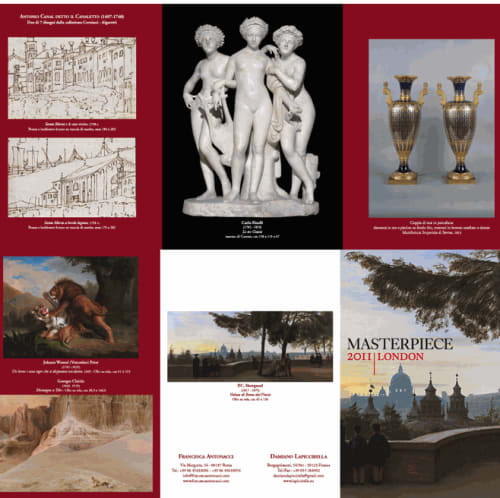MASTERPIECE LONDON 2011
The sculpture group by CARLO FINELLI (Carrara 1785 – Rome 1853)
THE THREE GRACES, 1830 c. in Carrara marble (cm. 158x119x67). Provenance: Camuccini collection, Cantalupo-Italy.
With this work Finelli returns on the theme of the three female figures which he already worked at in his work of the Ore Danzanti (Dancing hours) today exhibited at the Museum of the Hermitage. The genesis of The Three Graces evolved from a determination of absolute perfection, enhanced by a confrontation with the works realized by Canova and Thorvaldsen with similar themes. After having destroyed the first two models in plaster, Finelli decided to sculpt the work “alla prima” (“at the first”), which means directly in marble (without a plaster model), a daring technique and also exceptional for the epoch that determined the analogies between Finelli and the great master of Michelangelo. The group, however, was never finished and this singular event of its execution determined the decision of the heirs and of the students to leave the work unfinished instead, like it usually happened for neoclassical sculptures to finish it.
The not finished of the Graces (hands and feet are only scrabbled) constitutes a unique case in the event of the polish and fine neoclassical sculpture and must not surprise who is around the masterpiece, that with the passing of time this episode created a famous legend.
According to Giuseppe Checchetelli, the biographer of Finelli of the XIX century, The Three Graces were the “most perfect” work produced by him.
The oil on canvas A LION AND A TIGER THAT DISPUTE OVER A DEER, 1809, cm 81 x 103, by JOHANN WENZEL (VENCESLAO) PETER (Karlsbad 1745 - Rome 1829).
Born in Bohemia, he made his artistic career in Rome. There, he became the most popular animalist painter of his time. In the Villa Borghese he painted frescoes of over 160 animals and participated in the decoration of palazzo Chigi and palazzo Altieri. At the beginning of the XIX century, Peter enjoyed an international fame. He took part in the circle of those painters who, by order of the Tsar’s wife, the Tsarina of Russia Catherine, reproduced to its natural size the Vatican Logge of Raffaello for the Winter Palace of the Hermitage. After his death, Pope Gregory XVI purchased eleven works still in his workshop, among which was the monumental Garden of Eden (Vatican Museums), where Peter had shown more than two hundred animals of the whole world, forming a kind of catalogue for the visitors of his workshop.
In 1809, a painting showing a Fight of a lion with a tiger by Peter, very close to the work presented here, appeared in an exhibition organized by the Napoleonic authorities in the Capitol in Rome. The picture was bought by the King of Naples Joachim Murat, who brought it to Naples. Coming from a Neapolitan collection, our picture was probably commissioned by a person close to Murat. A version without the deer of Fight of a lion with a tiger is kept today in the Vatican Museums.
The tiger and the lion fighting for a deer shown here are depicted with extraordinary naturalism. This painting testifies to Peter’s artistic virtuosity and his in depth knowledge of animals.
An exceptional VIEW OF ROME FROM THE PINCIO by the Danish artist P.C. SKOOVGARD (1817 – 1875) protagonist of the DANISH GOLDEN AGE and recognized as the most important Danish landscape painter to whom just this year his country dedicated a beautiful monographic exhibit. This painting, of an extraordinary measurement, cm 65 x 150, has a romantic atmosphere, intensity and quality with a magnificent view from Monte Pincio over Rome and San Peter’s Basilica. Nivaagaards Malerisamling in Kopenaghen (Nivaagaard’s Collection of Paintings) owns a nearly identical painting with the same measurements, dated 1861.

